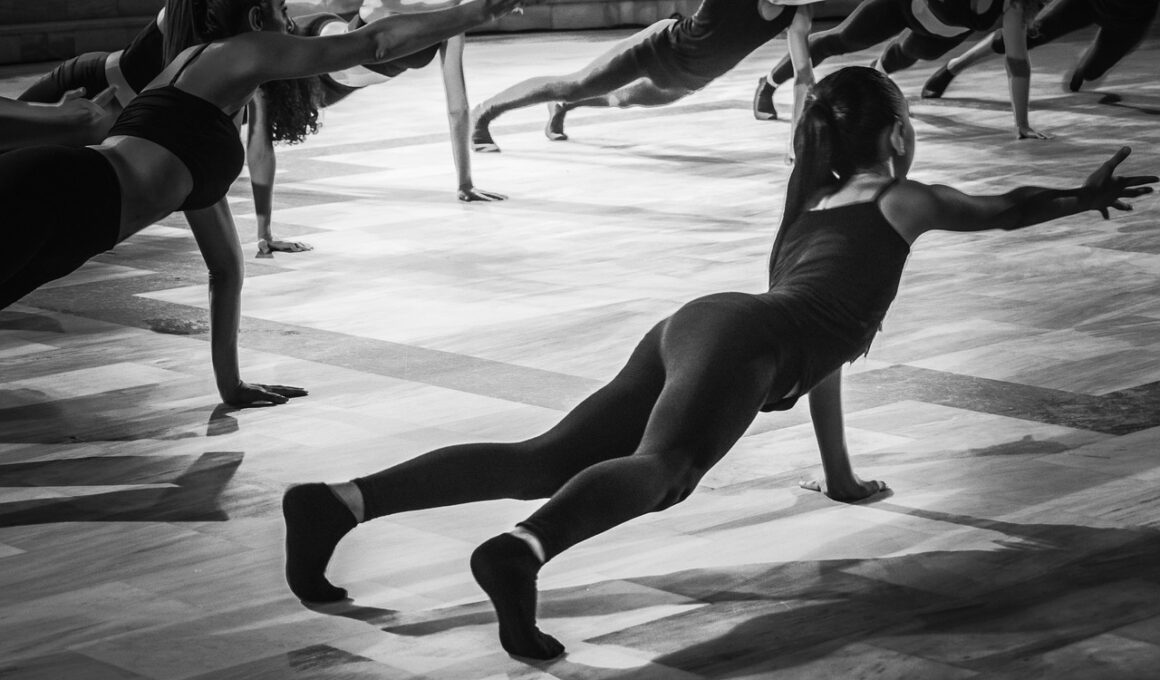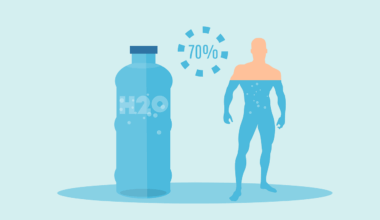The Science Behind Burning Calories with Dance Fitness
Dance fitness is more than just a fun activity; it is a scientifically-backed method for burning calories effectively. Studies have demonstrated that engaging in various dance styles during fitness sessions can lead to substantial caloric expenditure. Interestingly, this expenditure often varies depending on the intensity and duration of the dance workout. For instance, Zumba and hip-hop are typically higher in intensity than other types, enabling participants to burn more calories in less time. The movements involved in dance require a variety of muscle groups to work simultaneously, generating energy and boosting metabolism. Additionally, engaging in dance allows individuals to immerse themselves in rhythmic movements, which can elevate heart rates significantly. This cardio component is vital for caloric burn, pushing the body into a fat-burning state. Moreover, dance fitness routines can be tailored to individual fitness levels, promoting inclusivity and sustainability over time. Such adaptability is essential for ensuring that participants remain engaged and challenged. All these factors contribute to making dance fitness a powerful modality for those looking to manage their weight and enhance overall health. The fusion of enjoyment and exercise makes it a popular choice among many.
Another factor contributing to the caloric burn from dance fitness is the rhythmic nature of dance itself. The body’s rhythmic movements, in sync with music, encourage sustained effort over extended periods. This connection to music not only motivates individuals but also can create a sense of euphoria, commonly referred to as the “exercise high.” When individuals are enjoying themselves, they are less likely to notice the effort involved, leading to longer sessions. This psychological aspect plays a crucial role in enhancing performance and caloric burn. Furthermore, research indicates that participants in dance classes report higher levels of perceived exertion, which can lead to more substantial caloric expenditure. What makes dance fitness even more appealing is its community aspect, encouraging social interaction among participants. Engaging with others in a fun environment helps reinforce commitment and accountability to fitness goals. Many find that being part of a group fuels their motivation to return week after week. In contrast, solitary exercises may not offer the same level of engagement or enjoyment. Thus, dance fitness presents a unique approach that promotes both social camaraderie and individual health, making it an effective choice for diverse fitness enthusiasts.
Impact of Dance Styles on Caloric Expenditure
Various dance fitness styles yield different results regarding caloric burn. High-energy dance forms such as salsa, ballroom, and jazzercise can burn between 400 to 600 calories per hour. In contrast, gentler styles may yield fewer calories, which can still provide health benefits, especially for beginners or those building their fitness levels. Understanding these differences allows participants to tailor their workouts based on their goals. For example, those seeking maximum caloric expenditure may opt for fast-paced Latin-style dances or high-intensity interval training (HIIT) classes that incorporate dance movements. Notably, muscle engagement varies with dance styles; ballet, for instance, may focus more on core stability and strength, whereas hip-hop emphasizes agility and speed. It’s also essential for participants to recognize their heart rate zones, as training within specific zones can optimize caloric burn. Keeping track of time spent in moderate to vigorous exercise can provide insights into personal performance levels. By exploring different styles, individuals can find an enjoyable activity that suits their fitness goals and keeps them motivated. In turn, this exploration promotes long-term adherence to physical activity, ultimately supporting a healthier lifestyle.
The duration and frequency of dance fitness sessions significantly influence caloric burn and overall health benefits. To achieve desired results, consistency is key. Health experts recommend aiming for at least 150 minutes of moderate aerobic activity weekly, which can be achieved through several dance classes. By incorporating a regular schedule, individuals can better manage their weight and improve cardiovascular health. It is advisable to experiment with different classes and instructors to discover what resonates best with one’s preferences and abilities. Over time, participants may build endurance and confidence, potentially increasing workout intensity. Moreover, consistent routine workouts can lead to improved muscle tone and coordination, enhancing overall fitness. Participants can also track their progress using various apps and wearable devices, allowing them to see tangible results from their effort. This data helps inform future dance choices, enabling them to commit to more effective sessions in the long run. Furthermore, many dance facilities offer challenges and progression systems, motivating individuals to push their limits gradually. Through progressively challenging routines, participants can enhance their skills while optimizing their caloric burn during each session. Consequently, commitment to regular attendance is paramount for achieving desired fitness outcomes.
Benefits Beyond Caloric Burn
Another remarkable aspect of dance fitness is the range of benefits it offers beyond just caloric burn. Engaging in dance can significantly improve mental well-being and emotional health, providing a fulfilling escape from daily stressors. When people dance, their brains release endorphins, the body’s natural mood enhancers. These neurochemicals reduce feelings of pain and contribute to an overall sense of happiness. Such positive emotional responses can make any dance fitness session enjoyable, which encourages participants to return repeatedly. Additionally, dance fitness can enhance cognitive functions as well. Learning choreography improves memory and concentration, promoting brain health and reducing the risk of cognitive decline as one ages. This dual benefit of physical and mental stimulation makes dance fitness appealing to individuals of all ages, helping to cultivate appreciation for movement and music while maintaining fitness levels. Furthermore, many individuals find that dance can help combat feelings of anxiety or depression, providing an uplifting community environment. Bonding with fellow dancers through shared experiences fosters friendships and a sense of belonging. At its core, dance fitness transcends mere physical activity, emerging as a holistic approach to maintaining not just physical but mental well-being.
As dance fitness continues to evolve, trends such as virtual classes and on-demand workouts are becoming increasingly popular. The advent of technology has transformed traditional fitness spaces, allowing participants to explore classes from the comfort of their homes. This increased accessibility and convenience can encourage more individuals to engage in dance fitness. Moreover, with platforms offering various dance styles, individuals can tailor their fitness journey according to preferences, finding what resonates most with their lifestyle. Virtual communities have also emerged, allowing participants to interact and encourage each other, adding social elements akin to in-person classes. The flexibility of these classes enables individuals to fit their workouts into busy schedules, further enhancing adherence to fitness plans. As trends fluctuate, it is crucial to remain adaptable and embrace innovations in the dance fitness sphere. These possibilities show how the fitness industry is responding to the needs of participants, ensuring that enjoyment remains at the forefront of fitness engagement. Thus, as new trends emerge, individuals can confidently partake in dynamic and effective workouts that meet their demands. Staying updated with these trends can significantly impact motivation and drive sustained participation.
Conclusion: Embracing Dance Fitness
In conclusion, dance fitness is an excellent choice for those seeking a fun, effective way to burn calories while reaping a host of additional health benefits. With scientific backing highlighting its efficacy, the dance fitness approach facilitates enjoyment and personal growth through movement. Different dance styles provide ample opportunities to tailor workouts according to personal preferences and fitness goals. Individuals can emphasize high-energy dance forms for maximum caloric burn or incorporate gentler styles for a more accessible entry into physical activity. Regardless of the style, consistency remains the cornerstone of success in a dance fitness regimen, promoting not just weight management but overall well-being. The unexpected emotional and cognitive benefits of dance further enhance its appeal. Engaging with others in a supportive environment fosters community and motivation, enriching the experience. As trends continue to shape the future of dance fitness, adapting and exploring new options helps maintain enthusiasm for physical activity. Therefore, whether through in-person classes or virtual sessions, embracing dance fitness promises to yield delightful and transformative results. For individuals willing to indulge in movement, the world of dance fitness offers an exciting adventure toward improved health and wellness.
By exploring dance fitness, individuals not only achieve their fitness objectives but also enjoy the elements of rhythm, creativity, and self-expression. The focus is drawn away from conventional workouts, allowing for a more holistic approach to achieving fitness. Dance fitness accommodates a variety of styles and levels, making it an appealing option for anyone looking to shift their mindset about exercise. People can connect with music and movement uniquely and vibrantly, diving into rhythm and togetherness. The infusion of fun into the workout makes it easy to forget the calories being burned. Not only do individuals appear to burn calories, but they simultaneously engage in supportive community interaction. Moreover, participants discover new friendships, sharing experiences that bond them over time. Such connections become essential motives for returning to classes. Thus, pursuing dance fitness becomes not only a physical endeavor but also a joyous social experience. This blend of benefits makes it a lifestyle choice, ideally suited for today’s health-conscious individuals looking to enhance both physical fitness and mental enrichment. Ultimately, embracing dance fitness transforms fitness into an accessible, enjoyable, and sustainable journey.


